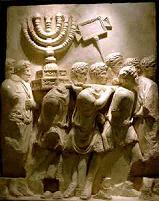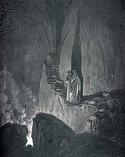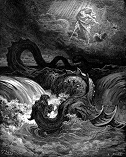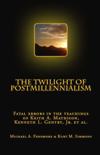MATTHEW 24 THE END OF THE HOLY CITY:
JERUSALEM AND JOSEPHUS.
An example of Rational Preterism
By Morrison Lee
The problem in understanding the prophecies of Matthew 24 is that readers take words and predictions (signs) out of a first century book and apply the words and signs yet future’ to their own generation. This article explains the historical background to the prophecies of Jesus by an eye witness to their fulfillment, Josephus, the Sanhedrin-appointed governor of Galilee, and the main source of our knowledge of the time.
The three conditions of any reasonable explanation are, firstly, it be suggested by the facts it is trying to explain: that is it saves the appearances of the facts, or in other words the explanation arises from our observation of the facts. Most simply, a satisfactory explanation is one that is always accountable to the facts by observation.
Secondly, from this starting point of being suggested by facts, a satisfactory theory will then go on to explain more and more facts; it answers more and more facts and gives new meaning to old facts and places them in new combinations. At the same time a good theory will explain the causes between these connections with facts, facts that may be observed.
Thirdly a good theory will predict new combinations of facts that have not been seen before. This can be challenging for some with a bias against novelty, but by their nature, every new truth is novel. A good theory will predict what is formerly unknown, but what must logically extend from the facts, just as an unseen pine tree root is predictable from pine tree leaves on a pine tree trunk.
The aims of this article are twofold; (i) to explain how a good theory works, and (ii) to explain the facts of Matthew 24 themselves. This article argues that Preterism is a preferable explanation because it does three things; it is suggested by biblical and historical facts, answers more facts, and predicts new relations between the facts of prophecy and history.
I. A first century explanation is suggested by the facts of Matthew 23-24
Matthew 23, 24 and 25 form part of a prophetic section of the book that is called the ‘mini apocalypse.’ These chapters discuss the end of the Mosaic world at the destruction of the holy city Jerusalem in 70 AD. That these events are peculiar to that generation of Moses in Judea is suggested by some clear facts: ‘All these things shall come upon this generation. O Jerusalem Jerusalem. .’ (Mtt 23:36-37a)
Here, in time, the facts state Jesus is speaking to His own generation in Jerusalem, forty years before the destruction of the Mosaic temple and the end of the age. It is also clear from the context and facts of Matthew 24:1-3 that Jesus is discussing the Mosaic temple, in which was the Mosaic covenant. (placed there by King Solomon exactly 1,000 years before. cf.1 Kgs 8:1 – 9:9)
And Jesus went out and departed from the temple, and His disciples came to Him for to show him the buildings of the temple. And Jesus said unto them, ‘See ye not all these things?’ ‘Verily I say unto you, there shall not be one stone upon another that shall not be thrown down.’ ...the disciples asked, ‘When shall these things be?...’
It is in reply to the disciples’ question ‘When shall these things be?’ that Jesus framed his response. In time and in space He speaks to those of his own generation who lived in land of Mosaic Judea before the destruction. This is why He warns; ‘Then let them which be in Judea flee into the mountains…’ (Mtt 24:16) It also explains His reference to escaping on the Sabbath day, the Sabbath being a Mosaic institution: ‘But let not your flight be not in the winter, neither on the Sabbath day.’ (Mtt 24:16)
Again, over halfway through the chapter, the facts state in the same terms, that Jesus expects these things to occur in His own [Mosaic] generation. ‘Verily I say to you this generation shall not pass away until all these things come to pass.’ (Mtt 24:34)
These facts suggest that Jesus is speaking to His own generation about a state of affairs occurring in their own lifetime, as indeed history demonstrates. His words herald the inevitable and terrible end to the nation prophesied by John Baptist at the start of His ministry when John said; ‘the axe is laid on the root’, the imminent fulfillment of what was foretold 1,000 years before saying; ‘I will cut off Israel of the land which I have given them; and this house which I have hallowed for my name will I cast out of my sight.’ (I Kgs 9:7) These prophecies also correspond to the historical events which shortly came to pass in Jesus’ generation in 70 AD.
II. A first century explanation answers the facts of Matthew 23-24
Just forty years after Jesus uttered the words of Matthew 24, on the 15th of Nisan 70AD, the national Jewish temple was surrounded by the Roman armies of Titus and sacked. (Exactly the same date in the same month as the first temple burned down in BC 586.) It was then plundered, dismantled stone by stone, its walls leveled with the ground, the land ploughed up and salted so that nothing would ever grow, and finally sold along with all Judea. The human cost was appalling. At the time of the Passover there were approximately 3,000,000 people trapped in the holy city. Of these approximately 1,100,000 died terrible deaths from famine and injury, and 97,000 were taken captive and sold to work in Egyptian mines, or eaten by wild beasts in games at Roman theatres. The decimation of the nation was cataclysmic, total, and definitive, the subject of a detailed prophecy fulfilled as recorded by eyewitness and historian Flavius Josephus in his work, Wars of the Jews. Following is a correlation of the tragic history with the tragic prophecy of Matthew 23 and 24.
Mtt 23:36-37 ‘All these things shall come upon this generation. O Jerusalem Jerusalem’
[40 years later] While the holy house was on fire, everything was plundered that came to hand, and ten thousand of those that were caught were slain…but children, and old men, and profane persons and priests, were all slain in the same manner. Wars 6:5:271
Yet was this misery itself more than the disorder; for one would have thought the hill itself on which the temple stood was seething hot, as full of fire on every part of it, that the blood was in larger quantity than the fire, and the slain more in number than those who slew them; for the ground did nowhere appear visible for the dead bodies that lay on it; but the soldiers went over heaps of these bodies as they ran upon such as fled from them.. Wars 6:5:275-276
..all this burning came upon Jerusalem…a city that had been liable to so many miseries during the siege that, had it always enjoyed as much happiness from its first foundation, it would have been the envy of the world. Nor did it…deserve such misfortunes, as by producing such a generation of men as were the occasions of this its overthrow. Wars 6:8:408
Mtt 24 2. Jerusalem temple was to be destroyed stone by stone.
Caesar gave orders that they should now demolish the entire city and temple..but for the rest of the wall, it was so thoroughly laid even with the ground by those that dug it up to the foundation, that there was left nothing to make those that came thither believe it had ever been inhabited. Wars 7:1:1,3
v7. Nation against nation, kingdom against Kingdom…end not yet.
.while Vespasian was about Alexandria, and Titus was lying at the siege of Jerusalem, a great multitude of the Germans were in commotion, and tended to rebellion, and as the Gauls in the neighborhood joined with them..hoping to free themselves of Roman dominion.. At the very same time with the forementioned revolt of the Germans did the bold attempt of the Scythians against the Romans occur, for those Scythians, who are called Samaitans, being a very numerous people, transported themselves over the Danube into Mysia without being perceived..and slew a great many Romans that guarded the frontiers. Wars 7:4:75ff
v7. Famine
Now of those who perished by famine in the city, the number was prodigious, and the miseries they underwent were unspeakable; for if the shadow of any kind of food did anywhere appear, a war was commenced presently; and the dearest friends fell a fighting one with another over it…nor would men believe those dying had no food, but the robbers would search them when they were expiring, lest any should have concealed food in their bosoms and counterfeited dying. Moreover their hunger was so intolerable that it obliged them to chew everything, while they gathered such things as the most sordid animals would not touch and endured to eat them; nor did they at length abstain from girdles and shoes, and the very leather which belonged to their shields they pulled off and gnawed; the very wisps of old hay became food to some, and some gathered up the fibers and sold a very small weight of them for four Attic drachmae. Wars 6:3:193-198
..I am going to relate a matter of fact the like to which no history relates, either among the Greeks or barbarians! It is horrible to speak of and incredible when heard…but that I have innumerable witnesses to it in my own age. ..a certain Mary, her father was Eleazar.. She was eminent for her family and her wealth, and had fled away to Jerusalem. [When it became impossible for her anyway to find more food, while the famine pierced through her very bowels…she then attempted a most unnatural thing; and snatching up her son, who was a child sucking at her breast she said; “O thou miserable infant! For whom shall I preserve thee in this war, this famine, this sedition? Come on: be thou my food…and a byword to the world..” As soon as she said this she slew her son, and roasted him, and ate one half of him, and kept the other half concealed. Wars 6:3:199ff.
v7. Earthquakes
..when the war about Actium was at the height, at the beginning of the Spring the earth was shaken, and destroyed an immense number of cattle, with thirty-thousand men, but the army received no harm because it lay in the open air. Wars 1:19:370
Moreover at the feast called Pentecost..the priest of the inner court felt a quaking Wars 6:5:298ff
v10. Many betray each other. (Cf Mtt 10:21)
And here, a certain old man - the father of seven children, whose children, together with their mother decided to give them leave to go out [to Herod] – slew them after the following manner: he ordered them to go out while he himself stood at the cave’s mouth, and slew that son of his perpetually who went out. Herod was near enough to see this sight, and his bowels of compassion were moved at it… yet did he not relent at all…but reproached Herod for his lowness of descent and slew his wife as well as his children, and when he had thrown their dead bodies down the precipice, he at last threw himself down after them. Wars 1:17:312 ff.
v11. False prophets arise
A false prophet was the occasion of these peoples destruction, which had made a proclamation in the city that very day that God commanded them to get up on the temple, and they should receive miraculous signs of their deliverance. Wars 6:5:285
v14. Gospel preached to all world. Cf. Matt 10:23, Acts Col 1:23, Rom 15:19, 2 Tim 4:17
v15. Abomination of desolation in holy place.
‘Why do you trample upon dead bodies in this temple? And why do you pollute this holy house with the blood of both foreigners and Jews themselves?’ ‘..I do not force you to pollute your sanctuary…’ Wars 6:2:126
v21. Great tribulation not seen in world
..but the entire nation was now shut up by fate as in a prison, and the Roman army compassed the city when it was crowded with inhabitant. Accordingly the multitude of those that therein perished exceeded all the destructions that either men or God ever brought upon the world… Wars 6:9:428ff.
Accordingly, it appears to me, that the misfortunes of all men from the beginning of the world, if they be compared to these of the Jews, are not so considerable as they were.. Wars Preface:12
v24. False Christs, false prophets
A false prophet was the occasion of these people’s destruction, which made a public proclamation in the city that very day, that God commanded them to get up on the temple, and that they should receive miraculous signs of their deliverance. Wars 6:5:285
v26. Behold he is in the desert. Go not forth.
Festus sent [Roman forces] ..to fall upon those that had been seduced by a certain imposter, who promised them deliverance and freedom..if they would but follow him as far as the wilderness. Accordingly those forces .. destroyed both him that had deluded them, and those that were his followers also. Antiquities 20:9:188
v28. Wheresoever the carcass is, there will the eagles be gathered.
Now the King [Herod] had put up a large golden eagle over the great gate of the temple, of very great value, and had dedicated it to the temple. Wars 1:33:650ff
v29. Immediately after tribulation Sun darkened
While the holy house was on fire everything was plundered that came to hand ..Wars 6:5:271
one would have thought the whole city was on fire . Wars 6:5:272
Fires across the whole country blotted out the moon at night and tinted the sun red by day.
Moon not give its light
But Herod deprived this Matthias of the priesthood, and burnt the other Matthias who had raised the sedition, with his companions, alive. And that very night there was an eclipse of the moon. Antiquities 17:6:167
Stars fall from heaven
There was a star resembling a sword, which stood over the city, and a comet, that continued for a whole year. Wars 6:5:289
v29. Powers of heaven shaken.
..the Roman government in great internal disorder by the continual changes of its rulers, and understood that every part of the habitable earth under them was in an unsettled and tottering condition. Wars 7:4:79
v30. Sign of son of man in clouds of heaven, tribes mourn
So these publicly declared that this signal foreshadowed the desolation that was coming upon them…for, before sun setting, chariots and troops of soldiers in their armor were seen running about among the clouds and surrounding the cities…Moreover at the feast called Pentecost..the priest of the inner court felt a quaking and heard a great noise..and the sound of a multitude saying ‘Let us remove hence… Wars 6:5:298ff
III. A first century explanation predicts new relations in the Apocalypse
The book of Revelation is an embarrassment to the yet future view, for in 2000 years of critical study it has not only not been understood uniformly, its context has not even been determined, the consensus of scholars believing it was written in 96 AD from external reasoning. But what happens if you look into the book itself? What is the internal evidence for the context of Revelation? The conclusion must be that it was written before the holy city Jerusalem was destroyed. This is consistent with a first century explanation of Matthew 24. Does the idea of Jerusalem predict new relations in Revelation?
The Harlot of Revelation matches the Holy City Jerusalem.
A past explanation argues from the internal evidence of Revelation it was written: that Jerusalem is the biblical holy city (Neh. 11:1, 11:18, Is 48:2, 52:1, Dan 9:24, Matt 4:5, 27:53) the same city where their Lord was crucified (Rev 11:8) also likened to immoral Sodom and Gomorrah by Isaiah (Is 1:10) the same holy city in which the bridegroom’s voice [Jesus’ voice] was heard (Rev 18:23) and the harlot city wherein was all the blood of the prophets. (Rev18:24, 19:1-2, Matt 23:36) while the Mosaic temple was still standing, (Rev 11:1-2) A past view also suggests a natural correspondence between the two systems, earthly city Mosaic Jerusalem and heavenly city spiritual Jerusalem. This natural correspondence of systems is mirrored in the facts of Gal 4:21-31) again a correspondence between two women, one represented by Hagar (Jerusalem) and the other by Sarah, (New Jerusalem) and also by mountains, Mt Sinai, (Jerusalem) and the other by Mt Zion, (New Jerusalem) system representing law, (Mosaic Jerusalem) the other grace. (New Jerusalem).
The first century (Preterist) explanation proposes that Jerusalem is suggested by the facts of Revelation. What happens when a past hypothesis (the context of the destruction of Jerusalem in 70 AD) is overlaid on Revelation? The result is that we find a near correspondence between biblical prophecy and historical description. Ie.
A first century history matches the affairs of Revelation.
A sample Preterist synthesis of prophecy and history informs us that Vespasian’s Roman army under his son Titus surrounded a Jerusalem besieged by civil war, and a holy temple occupied by: a generation of villains so mad, that had the Romans made a longer delay the city would have been swallowed up by the earth, or destroyed as Sodom… (Is 1:10 Jerusalem Wars 5:13:566) a national event described by this eyewitness as the greatest [national] misery since its’ foundation, (Mtt 24:21 Jerusalem Wars 6:8:408) in which the number of those which perished [over 1,100,000] exceeded all the destructions ..ever brought on the world (Jerusalem Wars 6:9:429), a time when false prophets abounded, (Mtt 24:24 Jerusalem Wars 6:5:285) “the daily sacrifice” failed (Dan 9:27 Jerusalem Wars 6:2:94) when famine and pestilence affected the estimated 3,000,000 people in the city, (Rev 18:8 Jerusalem Wars 5:12) a famine so bad people searched the sewers for dung, (Rev 18:8 Jerusalem Wars 5:13:571) and one mother ate her own child for food (Wars 6:3:207 ) when a measure of wheat was sold for a talent of money (Rev 6:6 Jerusalem Wars 5:13:571) when men sought by death [by sword over death by starvation], but found it not, (Rev 9:6 Jerusalem Wars 5:12:517) a context when fire and blood mingled together, the blood in the lanes in such quantities that the whole city ran with blood, to such a degree indeed that the fire of many of the houses was quenched with these men’s blood (Rev 8:7 Jerusalem Wars 6:8:406ff) earthquakes (Rev 6:12 Jerusalem Wars 1:19:370 ) and signs in the heavens: (Rev 8:12 Jerusalem Antiquities 17:6:167 Eclipse, comet) a time when the sounds of trumpets (Rev 8:13 Jerusalem Wars 6:1:68) and the noise of horses (Rev 9:16 Jerusalem Wars 3:2:33) were sounds to inspire dread and torment, (Rev 9:16 Jerusalem Wars 5:1:35) when the great plain in front of Jerusalem (Wars 5:2:67, 5:3:106ff) was leveled even wider by the four legions of the Roman army as numerous as locusts (Rev 9:3,7 Jerusalem Wars 4:9:536) to make a greater plain for battle. In 70 AD the entire city was shut up, the entire population of the nation captured, Josephus tells us, in a kind of net. (Matt 13:47 Jerusalem Wars 6:1:160) Our historian also tells us the time from the coming of the Roman Emperor Vespasian (in 66 AD) until the time the daily sacrifices failed to be offered in the temple was three and a half years, or forty two months, or times, times and half a time. (Rev 12:14, 13:5, Dan 9:27 Jerusalem Wars 6:2:94). This is complimentary correspondence between prophetic fate and actual fulfillment that doesn’t need an hypothesis of 2000 years.
A first century history matches many details of Revelation.
In Revelation 22 we have the prophetic destruction of a holy city in 42 months ‘soon to take place, shortly, quickly, soon’ to Jesus’ own generation. In historical Josephus we have the destruction of the holy city Jerusalem in 42 months in Jesus’ own generation.
Who will then dismiss the natural context of the first century, and this detailed correspondence as merely an accidental and not actual fulfillment? The futurist may pooh-pooh and dismiss a first century explanation with a wave of the hand, but this is too simple; (i) they have no better detailed explanation to offer, and (ii) must dismiss what is beyond coincidence as pure chance. This is unconvincing reasoning.
The futurist view cannot tell us anything of Jesus’ generation, but a Preterist view tells us it was an unsettled world revolved by wars in Rome, (Vitellus brought an army from Germany into Rome and took over the Italian government) Vespasian fighting in Egypt, Titus in Judea, the Idumeans against the Jews, the zealots against the ruling Sanhedrin and the people, the Sicarii (bandits) against everyone, the uprising in Gaul, the Syrians scheming against the Jews, the Scythians (called Sarmatians) invading borders along Germany, Scythians plundering Media, the Celte revolting, those beyond Euphrates warring, a world in turmoil that saw the Roman government in great internal disorder by the continual changes of its rulers, and understood that every part of the habitable earth under them was in an unsettled and tottering condition.. (Jerusalem Wars 7:4:75-95)
This is only a sample-Preterist explanation of the state of affairs existing in Jerusalem, Judea and all over the known world in the first century, yet it shows a near correspondence between biblical prophecy and history. Much more evidence may be produced to demonstrate the equivalence between Jerusalem and Revelation’s harlot city which crucified its Lord, (Rev 11:8) but here we are only concerned with making the link back to the first century, and demonstrating how a past viewpoint is suggested by biblical facts, answers more facts, and predicts new relations between facts.
Conclusion
The power of any explanation is its ability to save the appearances of the facts, and develop intricate linkages between those facts. This is called explanatory power, and is one of the key measures of a good explanation. A first century view has superior explanatory because it is always accountable to the first century as the natural context of a first century document, an aspect that saves the appearances of the biblical facts. A first century view is the simplest explanation consistent with observation.
Contrary-wise a yet future to us view turns its’ back to the past and peers into the future to connect the ideas of a first century book, but explains nothing except conjecture. The rule is when our theories do not fit our observations, theories must be changed. (Beck,S p82. The Simplicity of Science). The goal here is to seize factual solutions that answer the facts we observe, while deferring our judgment on remaining problems.
By the measure of explanatory power and the ability to save the appearances of the facts, a Preterist explanation is clearly to be preferred. June 2008
To receive Kurt Simmons’ e-mail newsletter, The Sword & The Plow, click the Subscribe link:
All rights reserved.






